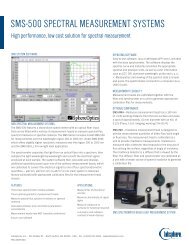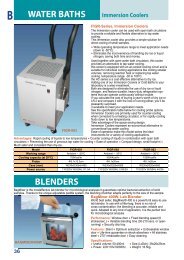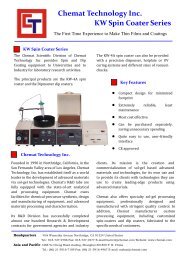S p e ctro m ete rs Ocean Optics pioneered the concept of ... - NDN
S p e ctro m ete rs Ocean Optics pioneered the concept of ... - NDN
S p e ctro m ete rs Ocean Optics pioneered the concept of ... - NDN
Create successful ePaper yourself
Turn your PDF publications into a flip-book with our unique Google optimized e-Paper software.
QE65000 and Maya Series Spe<strong>ctro</strong>m<strong>ete</strong><strong>rs</strong><br />
D<strong>ete</strong>cto<strong>rs</strong> and Accessories for Your High-sensitivity Spe<strong>ctro</strong>m<strong>ete</strong><strong>rs</strong><br />
Back-thinned Area D<strong>ete</strong>cto<strong>rs</strong><br />
The Hamamatsu FFT-CCD d<strong>ete</strong>cto<strong>rs</strong> used in <strong>the</strong> QE65000, Maya2000 and Maya2000 Pro have great<br />
UV response and provide up to 90% quantum efficiency (defined as how efficiently a photon is<br />
converted to a photo-ele<strong>ctro</strong>n). The QE65000 uses <strong>the</strong> S7031-1006 2D array d<strong>ete</strong>ctor, <strong>the</strong> Maya2000<br />
uses <strong>the</strong> S9840 d<strong>ete</strong>ctor and <strong>the</strong> Maya2000 Pro uses <strong>the</strong> S10420 d<strong>ete</strong>ctor. All three d<strong>ete</strong>cto<strong>rs</strong> are<br />
responsive from 200-1100 nm.<br />
D<strong>ete</strong>cto<strong>rs</strong> with OFLV Filte<strong>rs</strong><br />
OFLV Variable Longpass Order-sorting Filte<strong>rs</strong> are applied to <strong>the</strong> d<strong>ete</strong>ctor’s window to eliminate second- and third-order effects. We use a patented<br />
coating technology to apply <strong>the</strong> filter to <strong>the</strong> substrate.<br />
Spe<strong>ctro</strong>m<strong>ete</strong><strong>rs</strong><br />
QE65000 D<strong>ete</strong>ctor Options<br />
Item<br />
DET-QE<br />
DET-QE-OFLV-200<br />
DET-QE-OFLV-250<br />
DET-QE-OFLV-300<br />
DET-QE-OFLV-350<br />
DET-QE-OFLV-400<br />
DET-QE-WINDOWLESS<br />
Description<br />
Hamamatsu S7031 d<strong>ete</strong>ctor, installed, w/no variable longpass filter<br />
Hamamatsu S7031 d<strong>ete</strong>ctor, installed, w/OFLV-QE-200 variable longpass filter<br />
Hamamatsu S7031 d<strong>ete</strong>ctor, installed, w/OFLV-QE-250 variable longpass filter<br />
Hamamatsu S7031 d<strong>ete</strong>ctor, installed, w/OFLV-QE-300 variable longpass filter<br />
Hamamatsu S7031 d<strong>ete</strong>ctor, installed, w/OFLV-QE-350 variable longpass filter<br />
Hamamatsu S7031 d<strong>ete</strong>ctor, installed, w/OFLV-QE-400 variable longpass filter<br />
Hamamatsu S7031 d<strong>ete</strong>ctor, installed, with no window options; required for VUV applications<br />
Maya2000 and Maya2000 Pro D<strong>ete</strong>ctor Options<br />
Item Description Spe<strong>ctro</strong>m<strong>ete</strong>r<br />
DET-MAYA Hamamatsu S9840 d<strong>ete</strong>ctor, installed, w/no variable longpass filter Maya2000<br />
DET-MAYA-OFLV-200 Hamamatsu S9840 d<strong>ete</strong>ctor, installed, w/OFLV-200 variable longpass filter Maya2000<br />
DET-MAYA-UV Hamamatsu S9840 d<strong>ete</strong>ctor, installed, w/UV window Maya2000<br />
DET-MAYA-VIS Hamamatsu S9840 d<strong>ete</strong>ctor, installed, w/VIS window Maya2000<br />
DET-MAYA-WINDOWLESS Hamamatsu S9840 d<strong>ete</strong>ctor, installed, w/no window options; required for VUV applications Maya2000<br />
DET-MAYAPRO Hamamatsu S10420 d<strong>ete</strong>ctor, installed, w/no variable longpass filter Maya2000 Pro<br />
DET-MAYAPRO-OFLV-200 Hamamatsu S10420 d<strong>ete</strong>ctor, installed, w/OFLV-200 variable longpass filter Maya2000 Pro<br />
DET-MAYAPRO-UV Hamamatsu S10420 d<strong>ete</strong>ctor, installed, w/UV window Maya2000 Pro<br />
DET-MAYAPRO-VIS Hamamatsu S10420 d<strong>ete</strong>ctor, installed, w/VIS window Maya2000 Pro<br />
DET-MAYAPRO-WINDOWLESS Hamamatsu S10420 d<strong>ete</strong>ctor, installed, with no window options; required for VUV applications Maya2000 Pro<br />
Technical Tip<br />
Just as flexibility is built into your spe<strong>ctro</strong>m<strong>ete</strong>r options, so, too, is flexibility built in to your experiment param<strong>ete</strong><strong>rs</strong>. We<br />
use <strong>the</strong> term Scope Mode in s<strong>of</strong>tware to indicate “raw signal” coming from <strong>the</strong> spe<strong>ctro</strong>m<strong>ete</strong>r. The Scope Mode spectrum<br />
is <strong>the</strong> digital signal created from <strong>the</strong> d<strong>ete</strong>ctor’s analog signal, which is generated as <strong>the</strong> result <strong>of</strong> photons being<br />
converted into ele<strong>ctro</strong>ns. The arbitrary units <strong>of</strong> <strong>the</strong> Scope mode spectrum are called “counts.”<br />
By changing <strong>the</strong> integration time, adjusting signal averaging and so on you can condition <strong>the</strong> raw signal to maximize<br />
intensity or reduce noise, for example. Once you have optimized your base signal you are ready to enter a Processed Mode. Processed data<br />
involves taking a dark, taking a reference and <strong>the</strong>n going into a specific mode such as absorbance, transmission, reflection, relative irradiance,<br />
absolute irradiance, color and so on. In a Processed Mode <strong>the</strong> y-axis units are no longer arbitrary and <strong>the</strong>refore can be used to make qualitative,<br />
and is some cases quantitative, comparisons.<br />
www.oceanoptics.com Tel: +1 727-733-2447 45
















